Strategic Marketing Analysis and Evaluation: Toshiba Renewable Energy
VerifiedAdded on 2022/10/17
|17
|5774
|28
Report
AI Summary
This report provides a comprehensive strategic marketing analysis of Toshiba's Renewable Energy & Storage business. It begins with a critical company analysis, evaluating Toshiba's position as a global leader in high technology, and then delves into a critical competitive analysis, comparing Toshiba to competitors like Lenovo and Apple. The report also includes a critical customer analysis, identifying Toshiba's target demographic and their purchasing behaviors. Strategic collaborations and contextual factors are examined, highlighting the importance of partnerships in the company's strategy. The second part of the report focuses on innovation strategies, international marketing strategies, and social and ethical considerations. Finally, the report addresses the challenges facing Toshiba Renewable Energy & Storage in the future, drawing conclusions and recommendations based on the analysis. The report uses references and appendices to support its findings.

Strategic Marketing
Paraphrase This Document
Need a fresh take? Get an instant paraphrase of this document with our AI Paraphraser
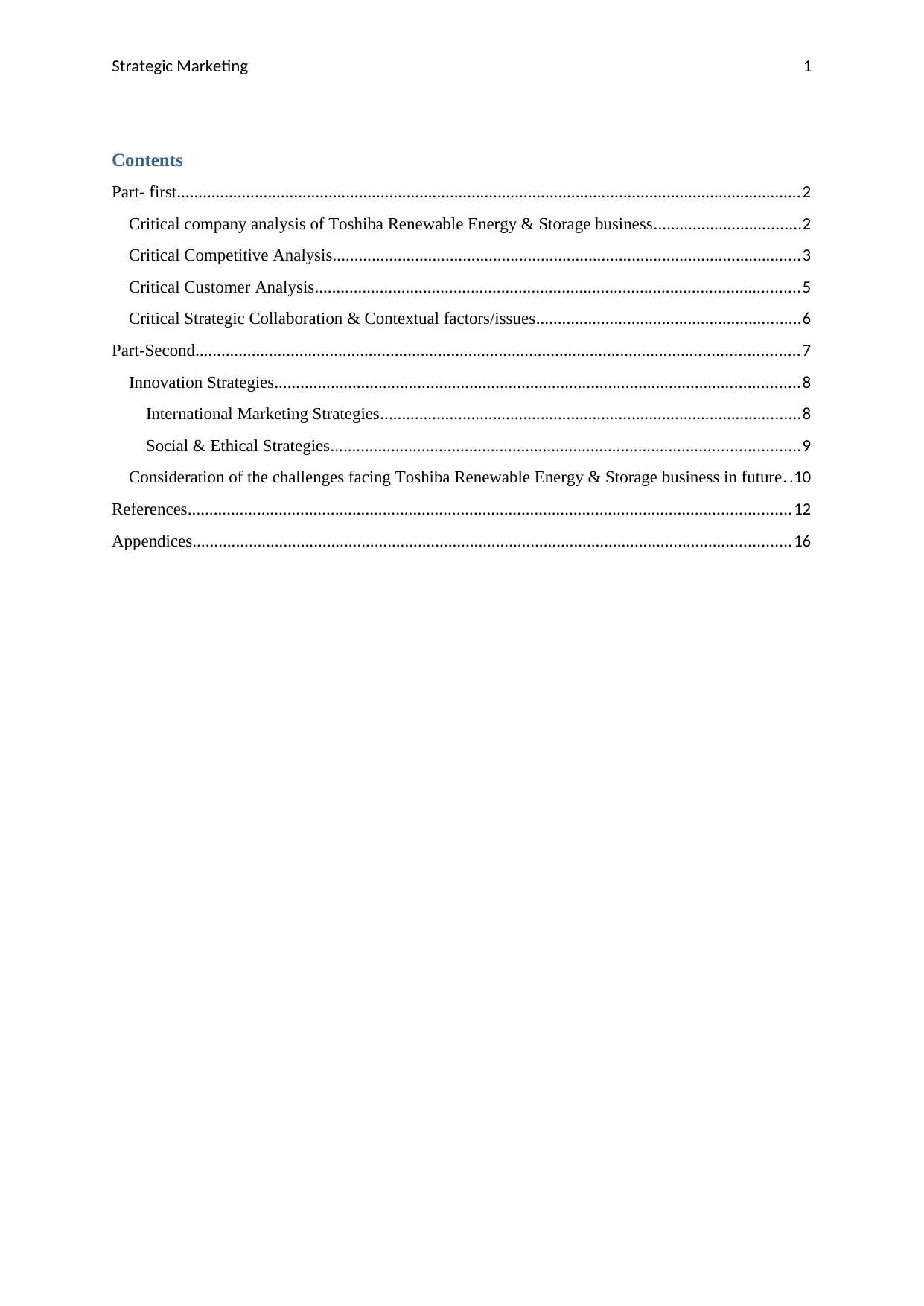
Strategic Marketing 1
Contents
Part- first................................................................................................................................................2
Critical company analysis of Toshiba Renewable Energy & Storage business..................................2
Critical Competitive Analysis............................................................................................................3
Critical Customer Analysis................................................................................................................5
Critical Strategic Collaboration & Contextual factors/issues.............................................................6
Part-Second...........................................................................................................................................7
Innovation Strategies.........................................................................................................................8
International Marketing Strategies.................................................................................................8
Social & Ethical Strategies............................................................................................................9
Consideration of the challenges facing Toshiba Renewable Energy & Storage business in future. .10
References...........................................................................................................................................12
Appendices..........................................................................................................................................16
Contents
Part- first................................................................................................................................................2
Critical company analysis of Toshiba Renewable Energy & Storage business..................................2
Critical Competitive Analysis............................................................................................................3
Critical Customer Analysis................................................................................................................5
Critical Strategic Collaboration & Contextual factors/issues.............................................................6
Part-Second...........................................................................................................................................7
Innovation Strategies.........................................................................................................................8
International Marketing Strategies.................................................................................................8
Social & Ethical Strategies............................................................................................................9
Consideration of the challenges facing Toshiba Renewable Energy & Storage business in future. .10
References...........................................................................................................................................12
Appendices..........................................................................................................................................16
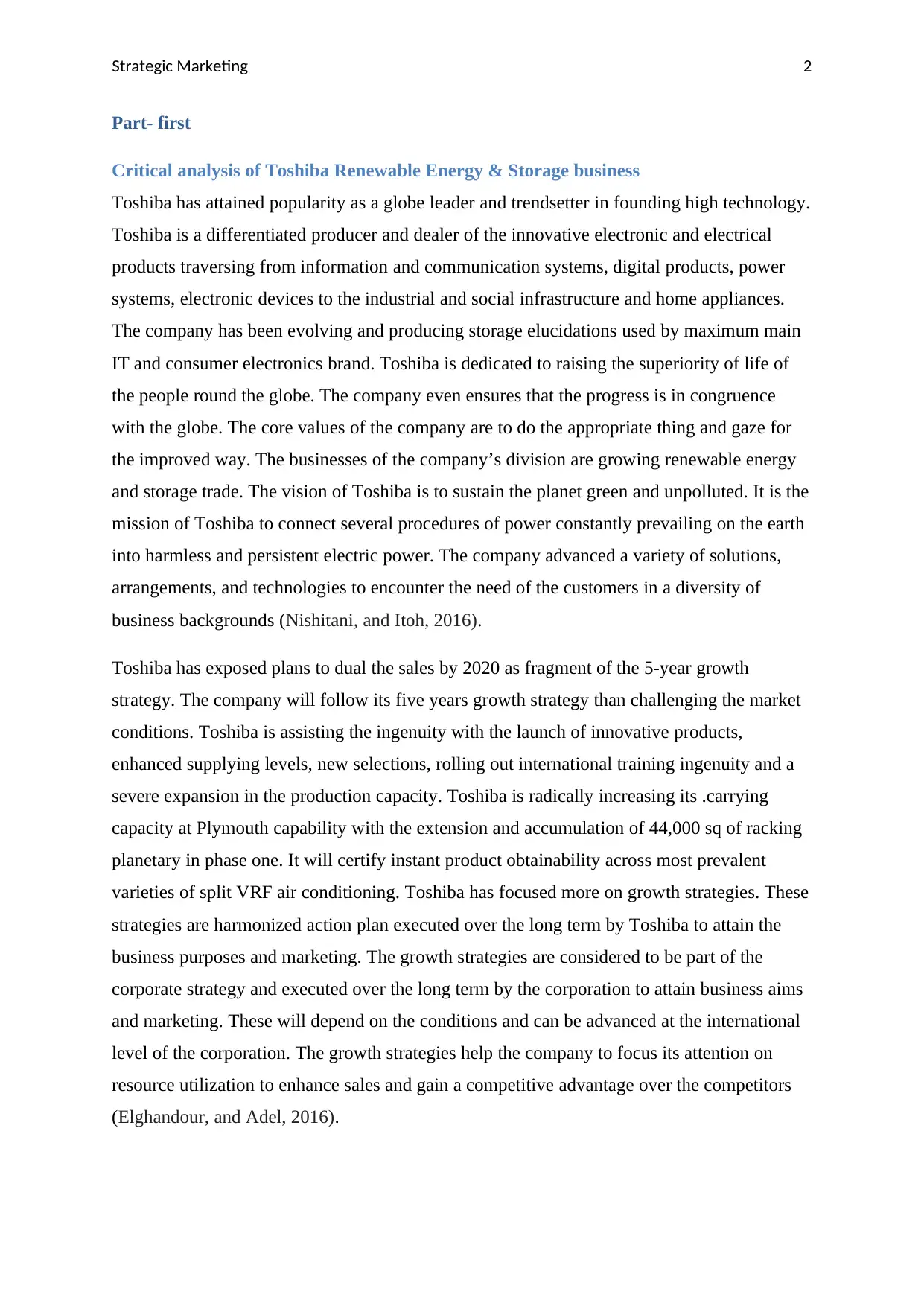
Strategic Marketing 2
Part- first
Critical analysis of Toshiba Renewable Energy & Storage business
Toshiba has attained popularity as a globe leader and trendsetter in founding high technology.
Toshiba is a differentiated producer and dealer of the innovative electronic and electrical
products traversing from information and communication systems, digital products, power
systems, electronic devices to the industrial and social infrastructure and home appliances.
The company has been evolving and producing storage elucidations used by maximum main
IT and consumer electronics brand. Toshiba is dedicated to raising the superiority of life of
the people round the globe. The company even ensures that the progress is in congruence
with the globe. The core values of the company are to do the appropriate thing and gaze for
the improved way. The businesses of the company’s division are growing renewable energy
and storage trade. The vision of Toshiba is to sustain the planet green and unpolluted. It is the
mission of Toshiba to connect several procedures of power constantly prevailing on the earth
into harmless and persistent electric power. The company advanced a variety of solutions,
arrangements, and technologies to encounter the need of the customers in a diversity of
business backgrounds (Nishitani, and Itoh, 2016).
Toshiba has exposed plans to dual the sales by 2020 as fragment of the 5-year growth
strategy. The company will follow its five years growth strategy than challenging the market
conditions. Toshiba is assisting the ingenuity with the launch of innovative products,
enhanced supplying levels, new selections, rolling out international training ingenuity and a
severe expansion in the production capacity. Toshiba is radically increasing its .carrying
capacity at Plymouth capability with the extension and accumulation of 44,000 sq of racking
planetary in phase one. It will certify instant product obtainability across most prevalent
varieties of split VRF air conditioning. Toshiba has focused more on growth strategies. These
strategies are harmonized action plan executed over the long term by Toshiba to attain the
business purposes and marketing. The growth strategies are considered to be part of the
corporate strategy and executed over the long term by the corporation to attain business aims
and marketing. These will depend on the conditions and can be advanced at the international
level of the corporation. The growth strategies help the company to focus its attention on
resource utilization to enhance sales and gain a competitive advantage over the competitors
(Elghandour, and Adel, 2016).
Part- first
Critical analysis of Toshiba Renewable Energy & Storage business
Toshiba has attained popularity as a globe leader and trendsetter in founding high technology.
Toshiba is a differentiated producer and dealer of the innovative electronic and electrical
products traversing from information and communication systems, digital products, power
systems, electronic devices to the industrial and social infrastructure and home appliances.
The company has been evolving and producing storage elucidations used by maximum main
IT and consumer electronics brand. Toshiba is dedicated to raising the superiority of life of
the people round the globe. The company even ensures that the progress is in congruence
with the globe. The core values of the company are to do the appropriate thing and gaze for
the improved way. The businesses of the company’s division are growing renewable energy
and storage trade. The vision of Toshiba is to sustain the planet green and unpolluted. It is the
mission of Toshiba to connect several procedures of power constantly prevailing on the earth
into harmless and persistent electric power. The company advanced a variety of solutions,
arrangements, and technologies to encounter the need of the customers in a diversity of
business backgrounds (Nishitani, and Itoh, 2016).
Toshiba has exposed plans to dual the sales by 2020 as fragment of the 5-year growth
strategy. The company will follow its five years growth strategy than challenging the market
conditions. Toshiba is assisting the ingenuity with the launch of innovative products,
enhanced supplying levels, new selections, rolling out international training ingenuity and a
severe expansion in the production capacity. Toshiba is radically increasing its .carrying
capacity at Plymouth capability with the extension and accumulation of 44,000 sq of racking
planetary in phase one. It will certify instant product obtainability across most prevalent
varieties of split VRF air conditioning. Toshiba has focused more on growth strategies. These
strategies are harmonized action plan executed over the long term by Toshiba to attain the
business purposes and marketing. The growth strategies are considered to be part of the
corporate strategy and executed over the long term by the corporation to attain business aims
and marketing. These will depend on the conditions and can be advanced at the international
level of the corporation. The growth strategies help the company to focus its attention on
resource utilization to enhance sales and gain a competitive advantage over the competitors
(Elghandour, and Adel, 2016).
⊘ This is a preview!⊘
Do you want full access?
Subscribe today to unlock all pages.

Trusted by 1+ million students worldwide
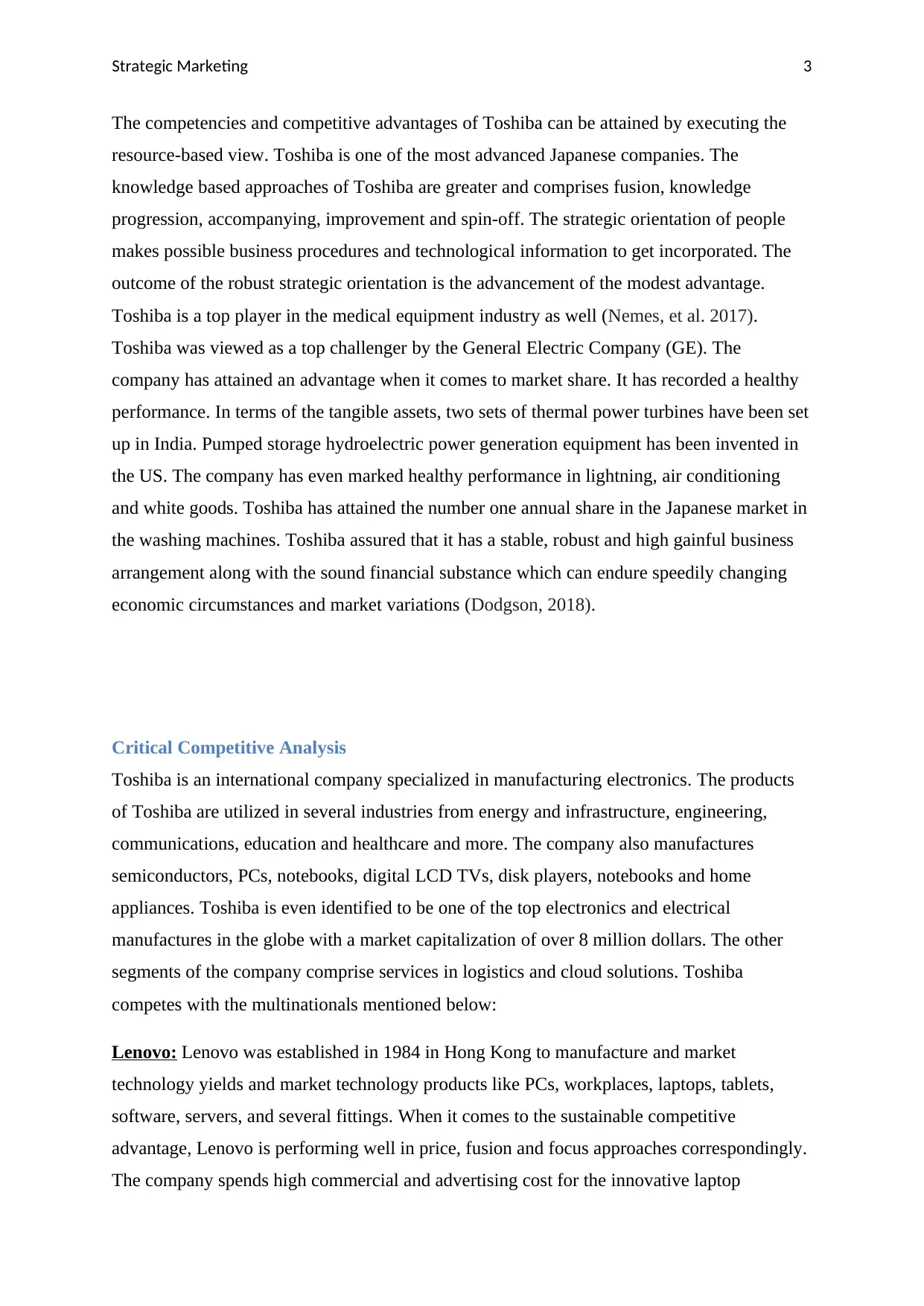
Strategic Marketing 3
The competencies and competitive advantages of Toshiba can be attained by executing the
resource-based view. Toshiba is one of the most advanced Japanese companies. The
knowledge based approaches of Toshiba are greater and comprises fusion, knowledge
progression, accompanying, improvement and spin-off. The strategic orientation of people
makes possible business procedures and technological information to get incorporated. The
outcome of the robust strategic orientation is the advancement of the modest advantage.
Toshiba is a top player in the medical equipment industry as well (Nemes, et al. 2017).
Toshiba was viewed as a top challenger by the General Electric Company (GE). The
company has attained an advantage when it comes to market share. It has recorded a healthy
performance. In terms of the tangible assets, two sets of thermal power turbines have been set
up in India. Pumped storage hydroelectric power generation equipment has been invented in
the US. The company has even marked healthy performance in lightning, air conditioning
and white goods. Toshiba has attained the number one annual share in the Japanese market in
the washing machines. Toshiba assured that it has a stable, robust and high gainful business
arrangement along with the sound financial substance which can endure speedily changing
economic circumstances and market variations (Dodgson, 2018).
Critical Competitive Analysis
Toshiba is an international company specialized in manufacturing electronics. The products
of Toshiba are utilized in several industries from energy and infrastructure, engineering,
communications, education and healthcare and more. The company also manufactures
semiconductors, PCs, notebooks, digital LCD TVs, disk players, notebooks and home
appliances. Toshiba is even identified to be one of the top electronics and electrical
manufactures in the globe with a market capitalization of over 8 million dollars. The other
segments of the company comprise services in logistics and cloud solutions. Toshiba
competes with the multinationals mentioned below:
Lenovo: Lenovo was established in 1984 in Hong Kong to manufacture and market
technology yields and market technology products like PCs, workplaces, laptops, tablets,
software, servers, and several fittings. When it comes to the sustainable competitive
advantage, Lenovo is performing well in price, fusion and focus approaches correspondingly.
The company spends high commercial and advertising cost for the innovative laptop
The competencies and competitive advantages of Toshiba can be attained by executing the
resource-based view. Toshiba is one of the most advanced Japanese companies. The
knowledge based approaches of Toshiba are greater and comprises fusion, knowledge
progression, accompanying, improvement and spin-off. The strategic orientation of people
makes possible business procedures and technological information to get incorporated. The
outcome of the robust strategic orientation is the advancement of the modest advantage.
Toshiba is a top player in the medical equipment industry as well (Nemes, et al. 2017).
Toshiba was viewed as a top challenger by the General Electric Company (GE). The
company has attained an advantage when it comes to market share. It has recorded a healthy
performance. In terms of the tangible assets, two sets of thermal power turbines have been set
up in India. Pumped storage hydroelectric power generation equipment has been invented in
the US. The company has even marked healthy performance in lightning, air conditioning
and white goods. Toshiba has attained the number one annual share in the Japanese market in
the washing machines. Toshiba assured that it has a stable, robust and high gainful business
arrangement along with the sound financial substance which can endure speedily changing
economic circumstances and market variations (Dodgson, 2018).
Critical Competitive Analysis
Toshiba is an international company specialized in manufacturing electronics. The products
of Toshiba are utilized in several industries from energy and infrastructure, engineering,
communications, education and healthcare and more. The company also manufactures
semiconductors, PCs, notebooks, digital LCD TVs, disk players, notebooks and home
appliances. Toshiba is even identified to be one of the top electronics and electrical
manufactures in the globe with a market capitalization of over 8 million dollars. The other
segments of the company comprise services in logistics and cloud solutions. Toshiba
competes with the multinationals mentioned below:
Lenovo: Lenovo was established in 1984 in Hong Kong to manufacture and market
technology yields and market technology products like PCs, workplaces, laptops, tablets,
software, servers, and several fittings. When it comes to the sustainable competitive
advantage, Lenovo is performing well in price, fusion and focus approaches correspondingly.
The company spends high commercial and advertising cost for the innovative laptop
Paraphrase This Document
Need a fresh take? Get an instant paraphrase of this document with our AI Paraphraser
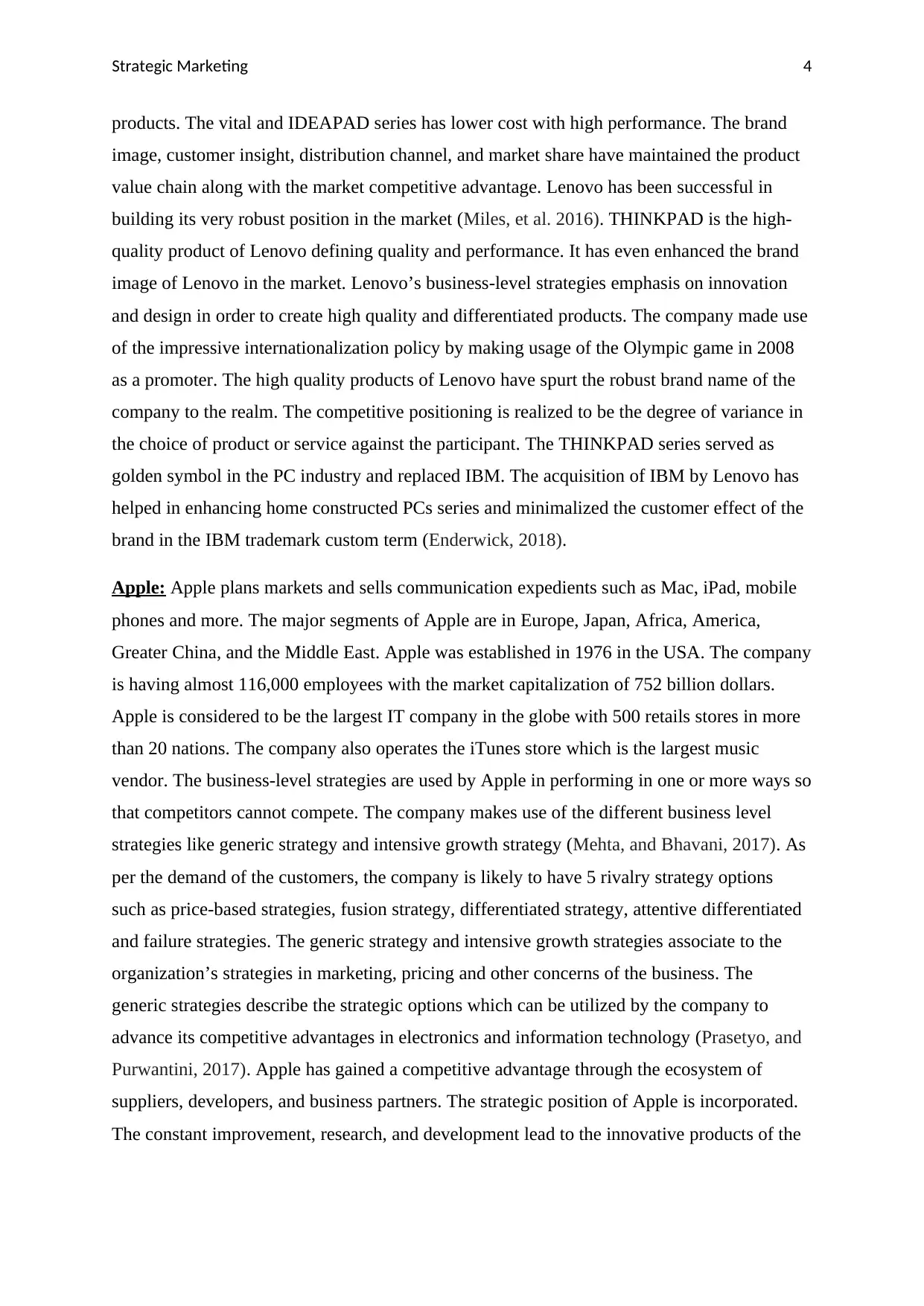
Strategic Marketing 4
products. The vital and IDEAPAD series has lower cost with high performance. The brand
image, customer insight, distribution channel, and market share have maintained the product
value chain along with the market competitive advantage. Lenovo has been successful in
building its very robust position in the market (Miles, et al. 2016). THINKPAD is the high-
quality product of Lenovo defining quality and performance. It has even enhanced the brand
image of Lenovo in the market. Lenovo’s business-level strategies emphasis on innovation
and design in order to create high quality and differentiated products. The company made use
of the impressive internationalization policy by making usage of the Olympic game in 2008
as a promoter. The high quality products of Lenovo have spurt the robust brand name of the
company to the realm. The competitive positioning is realized to be the degree of variance in
the choice of product or service against the participant. The THINKPAD series served as
golden symbol in the PC industry and replaced IBM. The acquisition of IBM by Lenovo has
helped in enhancing home constructed PCs series and minimalized the customer effect of the
brand in the IBM trademark custom term (Enderwick, 2018).
Apple: Apple plans markets and sells communication expedients such as Mac, iPad, mobile
phones and more. The major segments of Apple are in Europe, Japan, Africa, America,
Greater China, and the Middle East. Apple was established in 1976 in the USA. The company
is having almost 116,000 employees with the market capitalization of 752 billion dollars.
Apple is considered to be the largest IT company in the globe with 500 retails stores in more
than 20 nations. The company also operates the iTunes store which is the largest music
vendor. The business-level strategies are used by Apple in performing in one or more ways so
that competitors cannot compete. The company makes use of the different business level
strategies like generic strategy and intensive growth strategy (Mehta, and Bhavani, 2017). As
per the demand of the customers, the company is likely to have 5 rivalry strategy options
such as price-based strategies, fusion strategy, differentiated strategy, attentive differentiated
and failure strategies. The generic strategy and intensive growth strategies associate to the
organization’s strategies in marketing, pricing and other concerns of the business. The
generic strategies describe the strategic options which can be utilized by the company to
advance its competitive advantages in electronics and information technology (Prasetyo, and
Purwantini, 2017). Apple has gained a competitive advantage through the ecosystem of
suppliers, developers, and business partners. The strategic position of Apple is incorporated.
The constant improvement, research, and development lead to the innovative products of the
products. The vital and IDEAPAD series has lower cost with high performance. The brand
image, customer insight, distribution channel, and market share have maintained the product
value chain along with the market competitive advantage. Lenovo has been successful in
building its very robust position in the market (Miles, et al. 2016). THINKPAD is the high-
quality product of Lenovo defining quality and performance. It has even enhanced the brand
image of Lenovo in the market. Lenovo’s business-level strategies emphasis on innovation
and design in order to create high quality and differentiated products. The company made use
of the impressive internationalization policy by making usage of the Olympic game in 2008
as a promoter. The high quality products of Lenovo have spurt the robust brand name of the
company to the realm. The competitive positioning is realized to be the degree of variance in
the choice of product or service against the participant. The THINKPAD series served as
golden symbol in the PC industry and replaced IBM. The acquisition of IBM by Lenovo has
helped in enhancing home constructed PCs series and minimalized the customer effect of the
brand in the IBM trademark custom term (Enderwick, 2018).
Apple: Apple plans markets and sells communication expedients such as Mac, iPad, mobile
phones and more. The major segments of Apple are in Europe, Japan, Africa, America,
Greater China, and the Middle East. Apple was established in 1976 in the USA. The company
is having almost 116,000 employees with the market capitalization of 752 billion dollars.
Apple is considered to be the largest IT company in the globe with 500 retails stores in more
than 20 nations. The company also operates the iTunes store which is the largest music
vendor. The business-level strategies are used by Apple in performing in one or more ways so
that competitors cannot compete. The company makes use of the different business level
strategies like generic strategy and intensive growth strategy (Mehta, and Bhavani, 2017). As
per the demand of the customers, the company is likely to have 5 rivalry strategy options
such as price-based strategies, fusion strategy, differentiated strategy, attentive differentiated
and failure strategies. The generic strategy and intensive growth strategies associate to the
organization’s strategies in marketing, pricing and other concerns of the business. The
generic strategies describe the strategic options which can be utilized by the company to
advance its competitive advantages in electronics and information technology (Prasetyo, and
Purwantini, 2017). Apple has gained a competitive advantage through the ecosystem of
suppliers, developers, and business partners. The strategic position of Apple is incorporated.
The constant improvement, research, and development lead to the innovative products of the
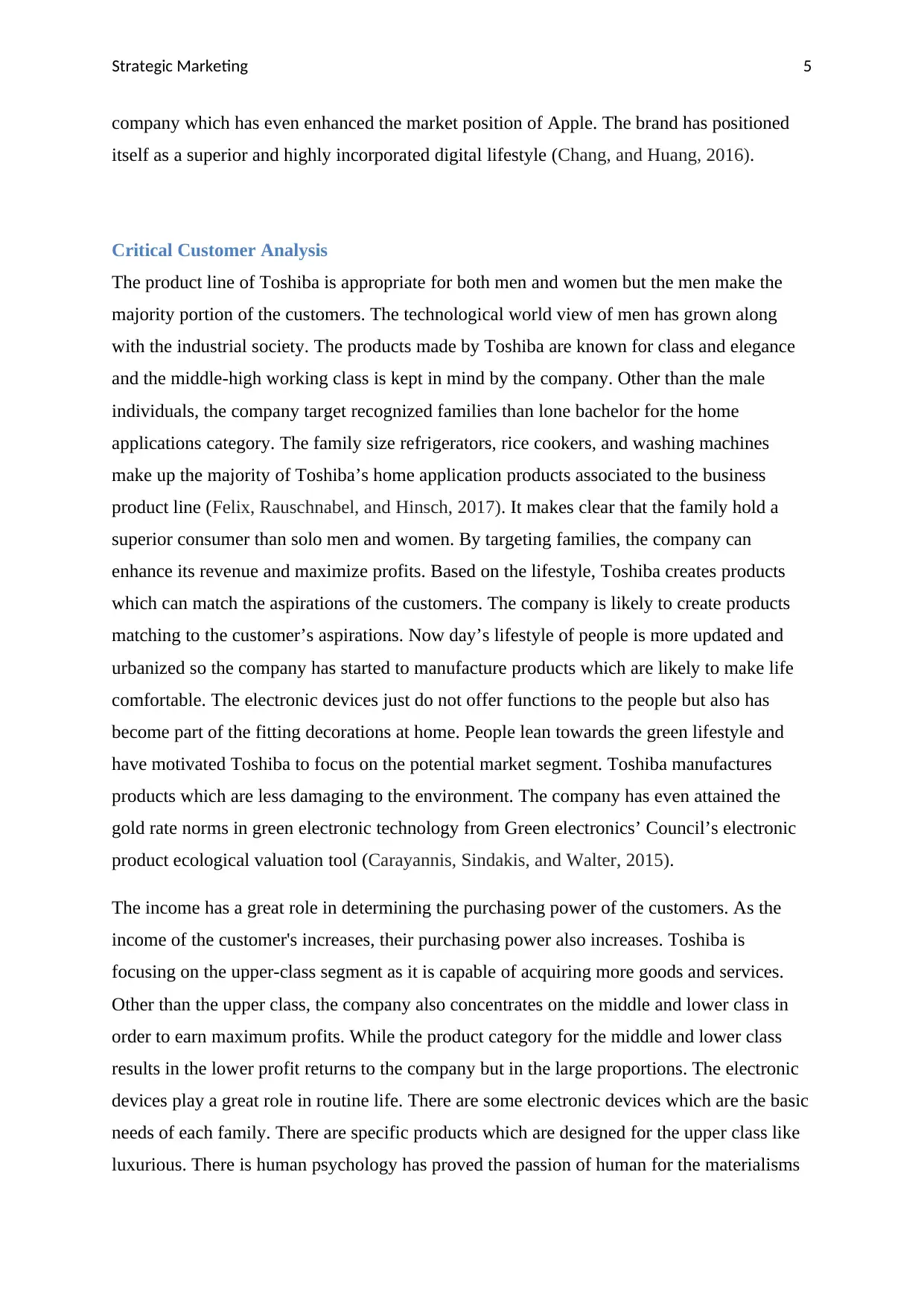
Strategic Marketing 5
company which has even enhanced the market position of Apple. The brand has positioned
itself as a superior and highly incorporated digital lifestyle (Chang, and Huang, 2016).
Critical Customer Analysis
The product line of Toshiba is appropriate for both men and women but the men make the
majority portion of the customers. The technological world view of men has grown along
with the industrial society. The products made by Toshiba are known for class and elegance
and the middle-high working class is kept in mind by the company. Other than the male
individuals, the company target recognized families than lone bachelor for the home
applications category. The family size refrigerators, rice cookers, and washing machines
make up the majority of Toshiba’s home application products associated to the business
product line (Felix, Rauschnabel, and Hinsch, 2017). It makes clear that the family hold a
superior consumer than solo men and women. By targeting families, the company can
enhance its revenue and maximize profits. Based on the lifestyle, Toshiba creates products
which can match the aspirations of the customers. The company is likely to create products
matching to the customer’s aspirations. Now day’s lifestyle of people is more updated and
urbanized so the company has started to manufacture products which are likely to make life
comfortable. The electronic devices just do not offer functions to the people but also has
become part of the fitting decorations at home. People lean towards the green lifestyle and
have motivated Toshiba to focus on the potential market segment. Toshiba manufactures
products which are less damaging to the environment. The company has even attained the
gold rate norms in green electronic technology from Green electronics’ Council’s electronic
product ecological valuation tool (Carayannis, Sindakis, and Walter, 2015).
The income has a great role in determining the purchasing power of the customers. As the
income of the customer's increases, their purchasing power also increases. Toshiba is
focusing on the upper-class segment as it is capable of acquiring more goods and services.
Other than the upper class, the company also concentrates on the middle and lower class in
order to earn maximum profits. While the product category for the middle and lower class
results in the lower profit returns to the company but in the large proportions. The electronic
devices play a great role in routine life. There are some electronic devices which are the basic
needs of each family. There are specific products which are designed for the upper class like
luxurious. There is human psychology has proved the passion of human for the materialisms
company which has even enhanced the market position of Apple. The brand has positioned
itself as a superior and highly incorporated digital lifestyle (Chang, and Huang, 2016).
Critical Customer Analysis
The product line of Toshiba is appropriate for both men and women but the men make the
majority portion of the customers. The technological world view of men has grown along
with the industrial society. The products made by Toshiba are known for class and elegance
and the middle-high working class is kept in mind by the company. Other than the male
individuals, the company target recognized families than lone bachelor for the home
applications category. The family size refrigerators, rice cookers, and washing machines
make up the majority of Toshiba’s home application products associated to the business
product line (Felix, Rauschnabel, and Hinsch, 2017). It makes clear that the family hold a
superior consumer than solo men and women. By targeting families, the company can
enhance its revenue and maximize profits. Based on the lifestyle, Toshiba creates products
which can match the aspirations of the customers. The company is likely to create products
matching to the customer’s aspirations. Now day’s lifestyle of people is more updated and
urbanized so the company has started to manufacture products which are likely to make life
comfortable. The electronic devices just do not offer functions to the people but also has
become part of the fitting decorations at home. People lean towards the green lifestyle and
have motivated Toshiba to focus on the potential market segment. Toshiba manufactures
products which are less damaging to the environment. The company has even attained the
gold rate norms in green electronic technology from Green electronics’ Council’s electronic
product ecological valuation tool (Carayannis, Sindakis, and Walter, 2015).
The income has a great role in determining the purchasing power of the customers. As the
income of the customer's increases, their purchasing power also increases. Toshiba is
focusing on the upper-class segment as it is capable of acquiring more goods and services.
Other than the upper class, the company also concentrates on the middle and lower class in
order to earn maximum profits. While the product category for the middle and lower class
results in the lower profit returns to the company but in the large proportions. The electronic
devices play a great role in routine life. There are some electronic devices which are the basic
needs of each family. There are specific products which are designed for the upper class like
luxurious. There is human psychology has proved the passion of human for the materialisms
⊘ This is a preview!⊘
Do you want full access?
Subscribe today to unlock all pages.

Trusted by 1+ million students worldwide
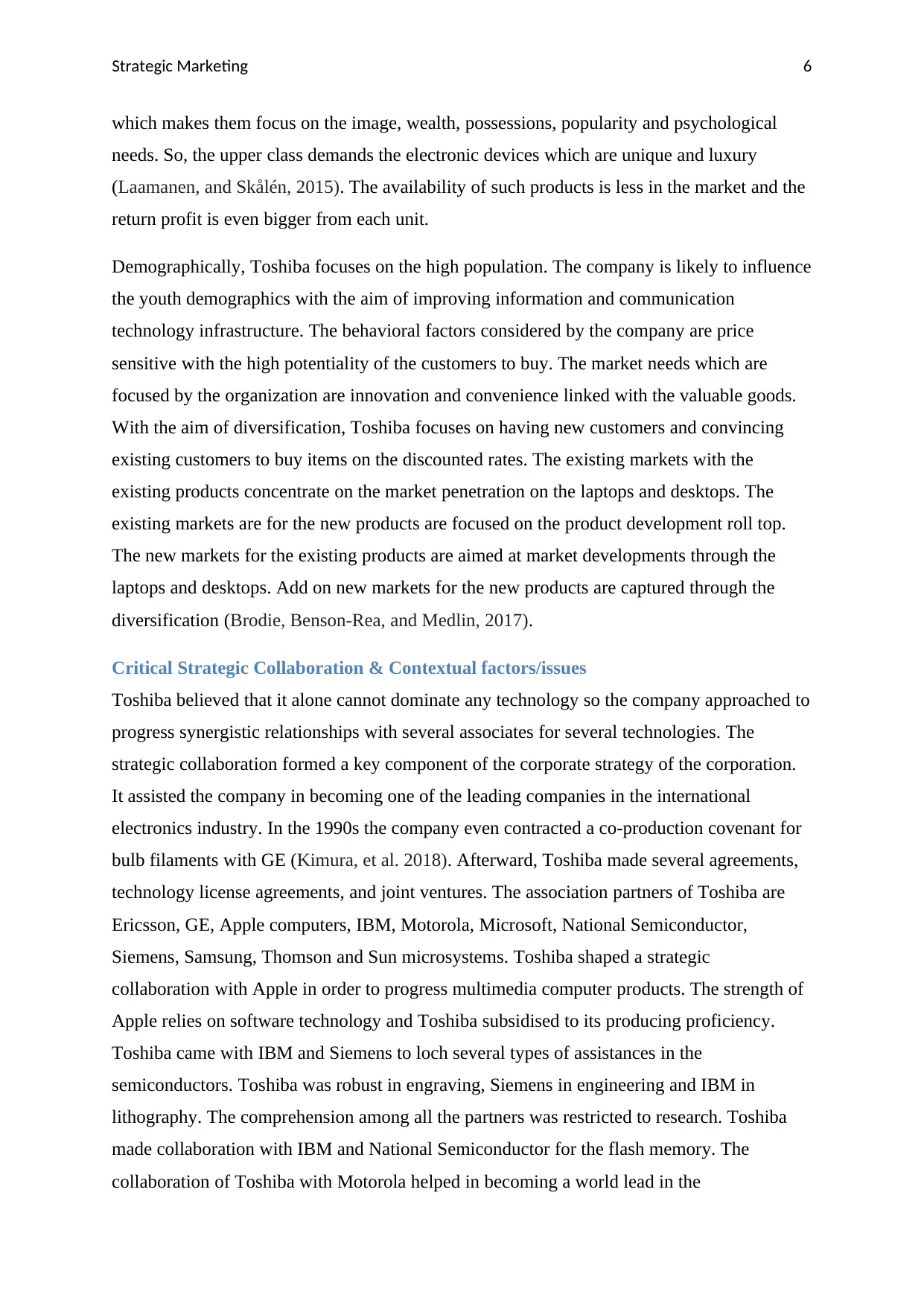
Strategic Marketing 6
which makes them focus on the image, wealth, possessions, popularity and psychological
needs. So, the upper class demands the electronic devices which are unique and luxury
(Laamanen, and Skålén, 2015). The availability of such products is less in the market and the
return profit is even bigger from each unit.
Demographically, Toshiba focuses on the high population. The company is likely to influence
the youth demographics with the aim of improving information and communication
technology infrastructure. The behavioral factors considered by the company are price
sensitive with the high potentiality of the customers to buy. The market needs which are
focused by the organization are innovation and convenience linked with the valuable goods.
With the aim of diversification, Toshiba focuses on having new customers and convincing
existing customers to buy items on the discounted rates. The existing markets with the
existing products concentrate on the market penetration on the laptops and desktops. The
existing markets are for the new products are focused on the product development roll top.
The new markets for the existing products are aimed at market developments through the
laptops and desktops. Add on new markets for the new products are captured through the
diversification (Brodie, Benson-Rea, and Medlin, 2017).
Critical Strategic Collaboration & Contextual factors/issues
Toshiba believed that it alone cannot dominate any technology so the company approached to
progress synergistic relationships with several associates for several technologies. The
strategic collaboration formed a key component of the corporate strategy of the corporation.
It assisted the company in becoming one of the leading companies in the international
electronics industry. In the 1990s the company even contracted a co-production covenant for
bulb filaments with GE (Kimura, et al. 2018). Afterward, Toshiba made several agreements,
technology license agreements, and joint ventures. The association partners of Toshiba are
Ericsson, GE, Apple computers, IBM, Motorola, Microsoft, National Semiconductor,
Siemens, Samsung, Thomson and Sun microsystems. Toshiba shaped a strategic
collaboration with Apple in order to progress multimedia computer products. The strength of
Apple relies on software technology and Toshiba subsidised to its producing proficiency.
Toshiba came with IBM and Siemens to loch several types of assistances in the
semiconductors. Toshiba was robust in engraving, Siemens in engineering and IBM in
lithography. The comprehension among all the partners was restricted to research. Toshiba
made collaboration with IBM and National Semiconductor for the flash memory. The
collaboration of Toshiba with Motorola helped in becoming a world lead in the
which makes them focus on the image, wealth, possessions, popularity and psychological
needs. So, the upper class demands the electronic devices which are unique and luxury
(Laamanen, and Skålén, 2015). The availability of such products is less in the market and the
return profit is even bigger from each unit.
Demographically, Toshiba focuses on the high population. The company is likely to influence
the youth demographics with the aim of improving information and communication
technology infrastructure. The behavioral factors considered by the company are price
sensitive with the high potentiality of the customers to buy. The market needs which are
focused by the organization are innovation and convenience linked with the valuable goods.
With the aim of diversification, Toshiba focuses on having new customers and convincing
existing customers to buy items on the discounted rates. The existing markets with the
existing products concentrate on the market penetration on the laptops and desktops. The
existing markets are for the new products are focused on the product development roll top.
The new markets for the existing products are aimed at market developments through the
laptops and desktops. Add on new markets for the new products are captured through the
diversification (Brodie, Benson-Rea, and Medlin, 2017).
Critical Strategic Collaboration & Contextual factors/issues
Toshiba believed that it alone cannot dominate any technology so the company approached to
progress synergistic relationships with several associates for several technologies. The
strategic collaboration formed a key component of the corporate strategy of the corporation.
It assisted the company in becoming one of the leading companies in the international
electronics industry. In the 1990s the company even contracted a co-production covenant for
bulb filaments with GE (Kimura, et al. 2018). Afterward, Toshiba made several agreements,
technology license agreements, and joint ventures. The association partners of Toshiba are
Ericsson, GE, Apple computers, IBM, Motorola, Microsoft, National Semiconductor,
Siemens, Samsung, Thomson and Sun microsystems. Toshiba shaped a strategic
collaboration with Apple in order to progress multimedia computer products. The strength of
Apple relies on software technology and Toshiba subsidised to its producing proficiency.
Toshiba came with IBM and Siemens to loch several types of assistances in the
semiconductors. Toshiba was robust in engraving, Siemens in engineering and IBM in
lithography. The comprehension among all the partners was restricted to research. Toshiba
made collaboration with IBM and National Semiconductor for the flash memory. The
collaboration of Toshiba with Motorola helped in becoming a world lead in the
Paraphrase This Document
Need a fresh take? Get an instant paraphrase of this document with our AI Paraphraser
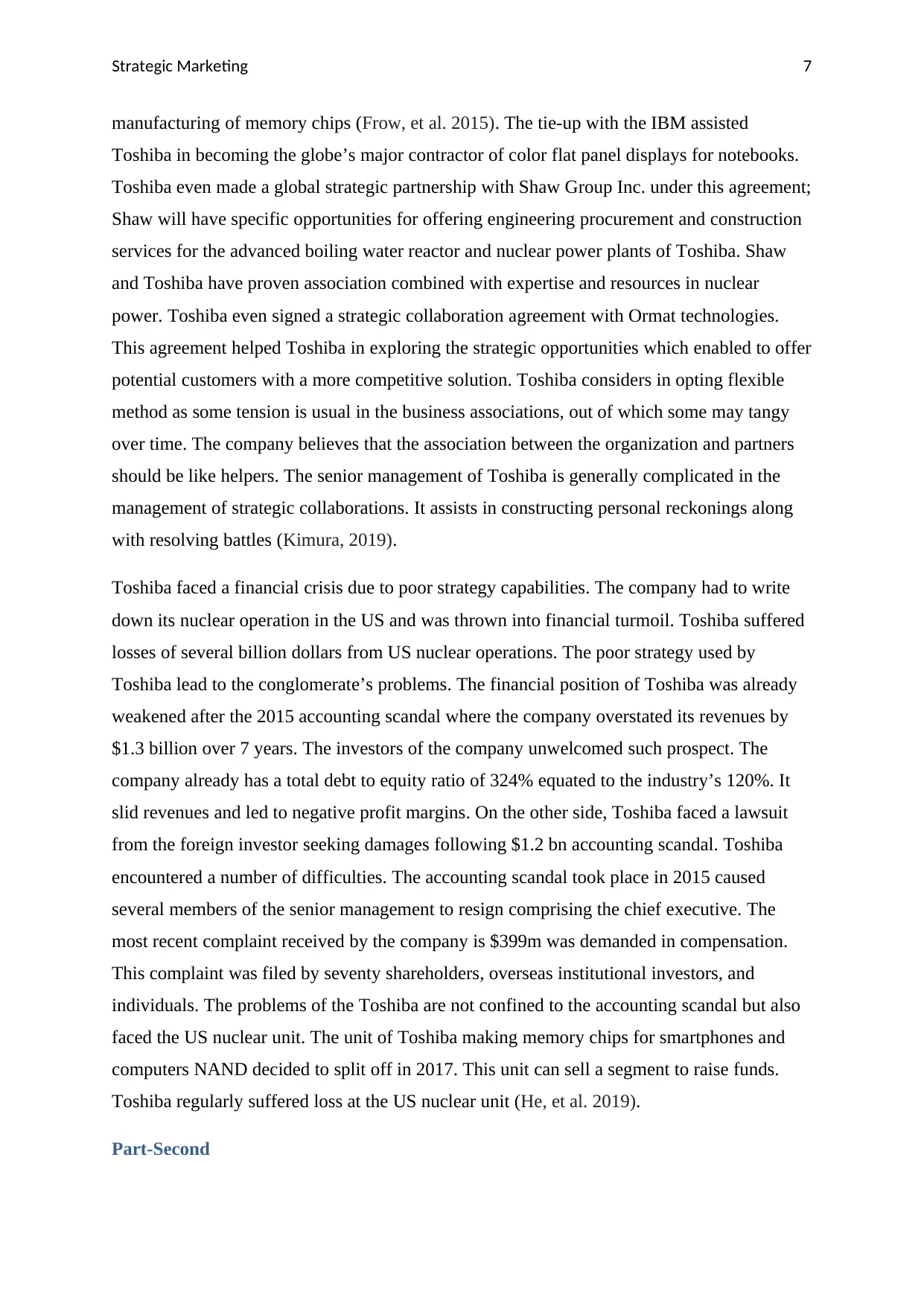
Strategic Marketing 7
manufacturing of memory chips (Frow, et al. 2015). The tie-up with the IBM assisted
Toshiba in becoming the globe’s major contractor of color flat panel displays for notebooks.
Toshiba even made a global strategic partnership with Shaw Group Inc. under this agreement;
Shaw will have specific opportunities for offering engineering procurement and construction
services for the advanced boiling water reactor and nuclear power plants of Toshiba. Shaw
and Toshiba have proven association combined with expertise and resources in nuclear
power. Toshiba even signed a strategic collaboration agreement with Ormat technologies.
This agreement helped Toshiba in exploring the strategic opportunities which enabled to offer
potential customers with a more competitive solution. Toshiba considers in opting flexible
method as some tension is usual in the business associations, out of which some may tangy
over time. The company believes that the association between the organization and partners
should be like helpers. The senior management of Toshiba is generally complicated in the
management of strategic collaborations. It assists in constructing personal reckonings along
with resolving battles (Kimura, 2019).
Toshiba faced a financial crisis due to poor strategy capabilities. The company had to write
down its nuclear operation in the US and was thrown into financial turmoil. Toshiba suffered
losses of several billion dollars from US nuclear operations. The poor strategy used by
Toshiba lead to the conglomerate’s problems. The financial position of Toshiba was already
weakened after the 2015 accounting scandal where the company overstated its revenues by
$1.3 billion over 7 years. The investors of the company unwelcomed such prospect. The
company already has a total debt to equity ratio of 324% equated to the industry’s 120%. It
slid revenues and led to negative profit margins. On the other side, Toshiba faced a lawsuit
from the foreign investor seeking damages following $1.2 bn accounting scandal. Toshiba
encountered a number of difficulties. The accounting scandal took place in 2015 caused
several members of the senior management to resign comprising the chief executive. The
most recent complaint received by the company is $399m was demanded in compensation.
This complaint was filed by seventy shareholders, overseas institutional investors, and
individuals. The problems of the Toshiba are not confined to the accounting scandal but also
faced the US nuclear unit. The unit of Toshiba making memory chips for smartphones and
computers NAND decided to split off in 2017. This unit can sell a segment to raise funds.
Toshiba regularly suffered loss at the US nuclear unit (He, et al. 2019).
Part-Second
manufacturing of memory chips (Frow, et al. 2015). The tie-up with the IBM assisted
Toshiba in becoming the globe’s major contractor of color flat panel displays for notebooks.
Toshiba even made a global strategic partnership with Shaw Group Inc. under this agreement;
Shaw will have specific opportunities for offering engineering procurement and construction
services for the advanced boiling water reactor and nuclear power plants of Toshiba. Shaw
and Toshiba have proven association combined with expertise and resources in nuclear
power. Toshiba even signed a strategic collaboration agreement with Ormat technologies.
This agreement helped Toshiba in exploring the strategic opportunities which enabled to offer
potential customers with a more competitive solution. Toshiba considers in opting flexible
method as some tension is usual in the business associations, out of which some may tangy
over time. The company believes that the association between the organization and partners
should be like helpers. The senior management of Toshiba is generally complicated in the
management of strategic collaborations. It assists in constructing personal reckonings along
with resolving battles (Kimura, 2019).
Toshiba faced a financial crisis due to poor strategy capabilities. The company had to write
down its nuclear operation in the US and was thrown into financial turmoil. Toshiba suffered
losses of several billion dollars from US nuclear operations. The poor strategy used by
Toshiba lead to the conglomerate’s problems. The financial position of Toshiba was already
weakened after the 2015 accounting scandal where the company overstated its revenues by
$1.3 billion over 7 years. The investors of the company unwelcomed such prospect. The
company already has a total debt to equity ratio of 324% equated to the industry’s 120%. It
slid revenues and led to negative profit margins. On the other side, Toshiba faced a lawsuit
from the foreign investor seeking damages following $1.2 bn accounting scandal. Toshiba
encountered a number of difficulties. The accounting scandal took place in 2015 caused
several members of the senior management to resign comprising the chief executive. The
most recent complaint received by the company is $399m was demanded in compensation.
This complaint was filed by seventy shareholders, overseas institutional investors, and
individuals. The problems of the Toshiba are not confined to the accounting scandal but also
faced the US nuclear unit. The unit of Toshiba making memory chips for smartphones and
computers NAND decided to split off in 2017. This unit can sell a segment to raise funds.
Toshiba regularly suffered loss at the US nuclear unit (He, et al. 2019).
Part-Second
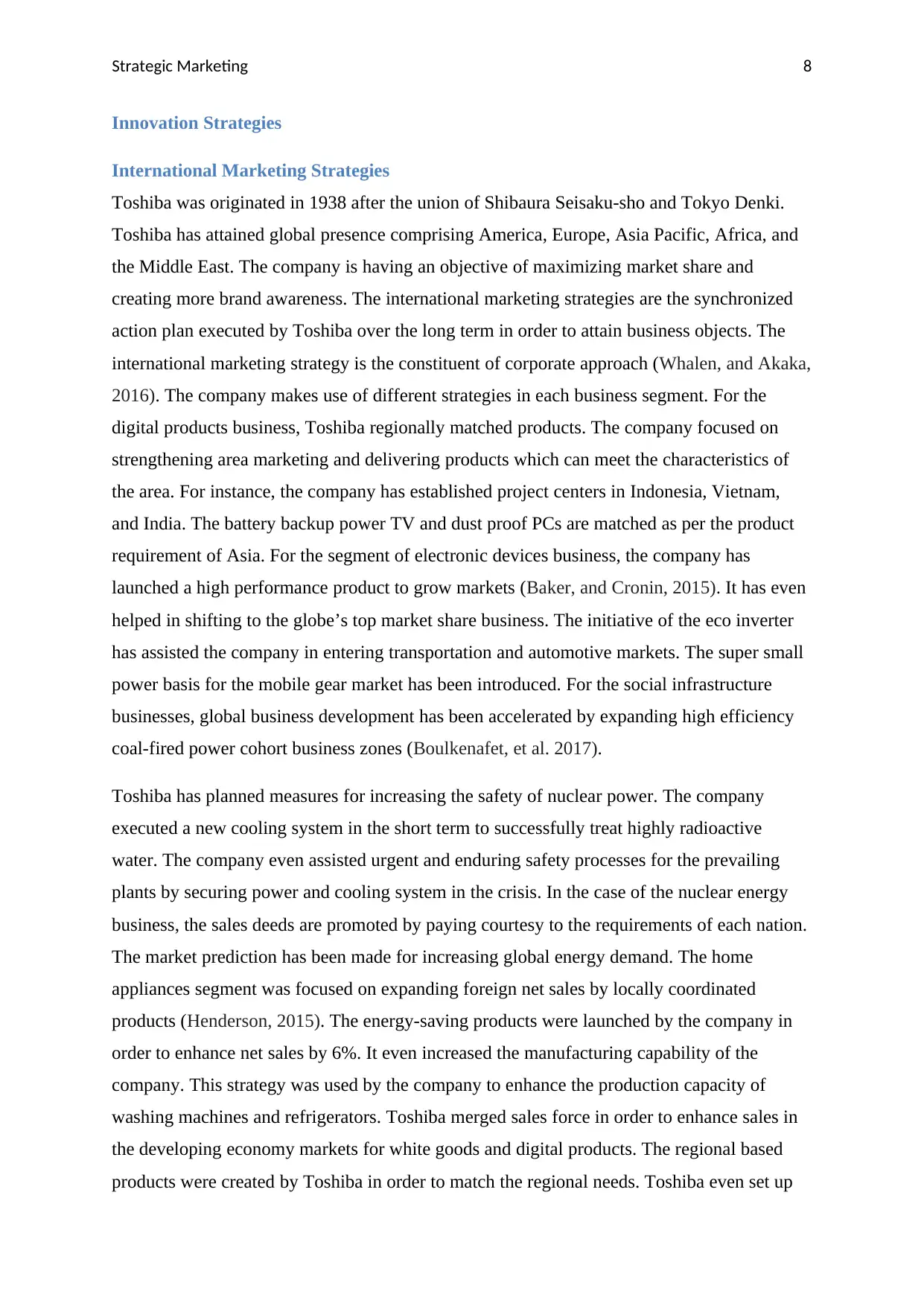
Strategic Marketing 8
Innovation Strategies
International Marketing Strategies
Toshiba was originated in 1938 after the union of Shibaura Seisaku-sho and Tokyo Denki.
Toshiba has attained global presence comprising America, Europe, Asia Pacific, Africa, and
the Middle East. The company is having an objective of maximizing market share and
creating more brand awareness. The international marketing strategies are the synchronized
action plan executed by Toshiba over the long term in order to attain business objects. The
international marketing strategy is the constituent of corporate approach (Whalen, and Akaka,
2016). The company makes use of different strategies in each business segment. For the
digital products business, Toshiba regionally matched products. The company focused on
strengthening area marketing and delivering products which can meet the characteristics of
the area. For instance, the company has established project centers in Indonesia, Vietnam,
and India. The battery backup power TV and dust proof PCs are matched as per the product
requirement of Asia. For the segment of electronic devices business, the company has
launched a high performance product to grow markets (Baker, and Cronin, 2015). It has even
helped in shifting to the globe’s top market share business. The initiative of the eco inverter
has assisted the company in entering transportation and automotive markets. The super small
power basis for the mobile gear market has been introduced. For the social infrastructure
businesses, global business development has been accelerated by expanding high efficiency
coal-fired power cohort business zones (Boulkenafet, et al. 2017).
Toshiba has planned measures for increasing the safety of nuclear power. The company
executed a new cooling system in the short term to successfully treat highly radioactive
water. The company even assisted urgent and enduring safety processes for the prevailing
plants by securing power and cooling system in the crisis. In the case of the nuclear energy
business, the sales deeds are promoted by paying courtesy to the requirements of each nation.
The market prediction has been made for increasing global energy demand. The home
appliances segment was focused on expanding foreign net sales by locally coordinated
products (Henderson, 2015). The energy-saving products were launched by the company in
order to enhance net sales by 6%. It even increased the manufacturing capability of the
company. This strategy was used by the company to enhance the production capacity of
washing machines and refrigerators. Toshiba merged sales force in order to enhance sales in
the developing economy markets for white goods and digital products. The regional based
products were created by Toshiba in order to match the regional needs. Toshiba even set up
Innovation Strategies
International Marketing Strategies
Toshiba was originated in 1938 after the union of Shibaura Seisaku-sho and Tokyo Denki.
Toshiba has attained global presence comprising America, Europe, Asia Pacific, Africa, and
the Middle East. The company is having an objective of maximizing market share and
creating more brand awareness. The international marketing strategies are the synchronized
action plan executed by Toshiba over the long term in order to attain business objects. The
international marketing strategy is the constituent of corporate approach (Whalen, and Akaka,
2016). The company makes use of different strategies in each business segment. For the
digital products business, Toshiba regionally matched products. The company focused on
strengthening area marketing and delivering products which can meet the characteristics of
the area. For instance, the company has established project centers in Indonesia, Vietnam,
and India. The battery backup power TV and dust proof PCs are matched as per the product
requirement of Asia. For the segment of electronic devices business, the company has
launched a high performance product to grow markets (Baker, and Cronin, 2015). It has even
helped in shifting to the globe’s top market share business. The initiative of the eco inverter
has assisted the company in entering transportation and automotive markets. The super small
power basis for the mobile gear market has been introduced. For the social infrastructure
businesses, global business development has been accelerated by expanding high efficiency
coal-fired power cohort business zones (Boulkenafet, et al. 2017).
Toshiba has planned measures for increasing the safety of nuclear power. The company
executed a new cooling system in the short term to successfully treat highly radioactive
water. The company even assisted urgent and enduring safety processes for the prevailing
plants by securing power and cooling system in the crisis. In the case of the nuclear energy
business, the sales deeds are promoted by paying courtesy to the requirements of each nation.
The market prediction has been made for increasing global energy demand. The home
appliances segment was focused on expanding foreign net sales by locally coordinated
products (Henderson, 2015). The energy-saving products were launched by the company in
order to enhance net sales by 6%. It even increased the manufacturing capability of the
company. This strategy was used by the company to enhance the production capacity of
washing machines and refrigerators. Toshiba merged sales force in order to enhance sales in
the developing economy markets for white goods and digital products. The regional based
products were created by Toshiba in order to match the regional needs. Toshiba even set up
⊘ This is a preview!⊘
Do you want full access?
Subscribe today to unlock all pages.

Trusted by 1+ million students worldwide
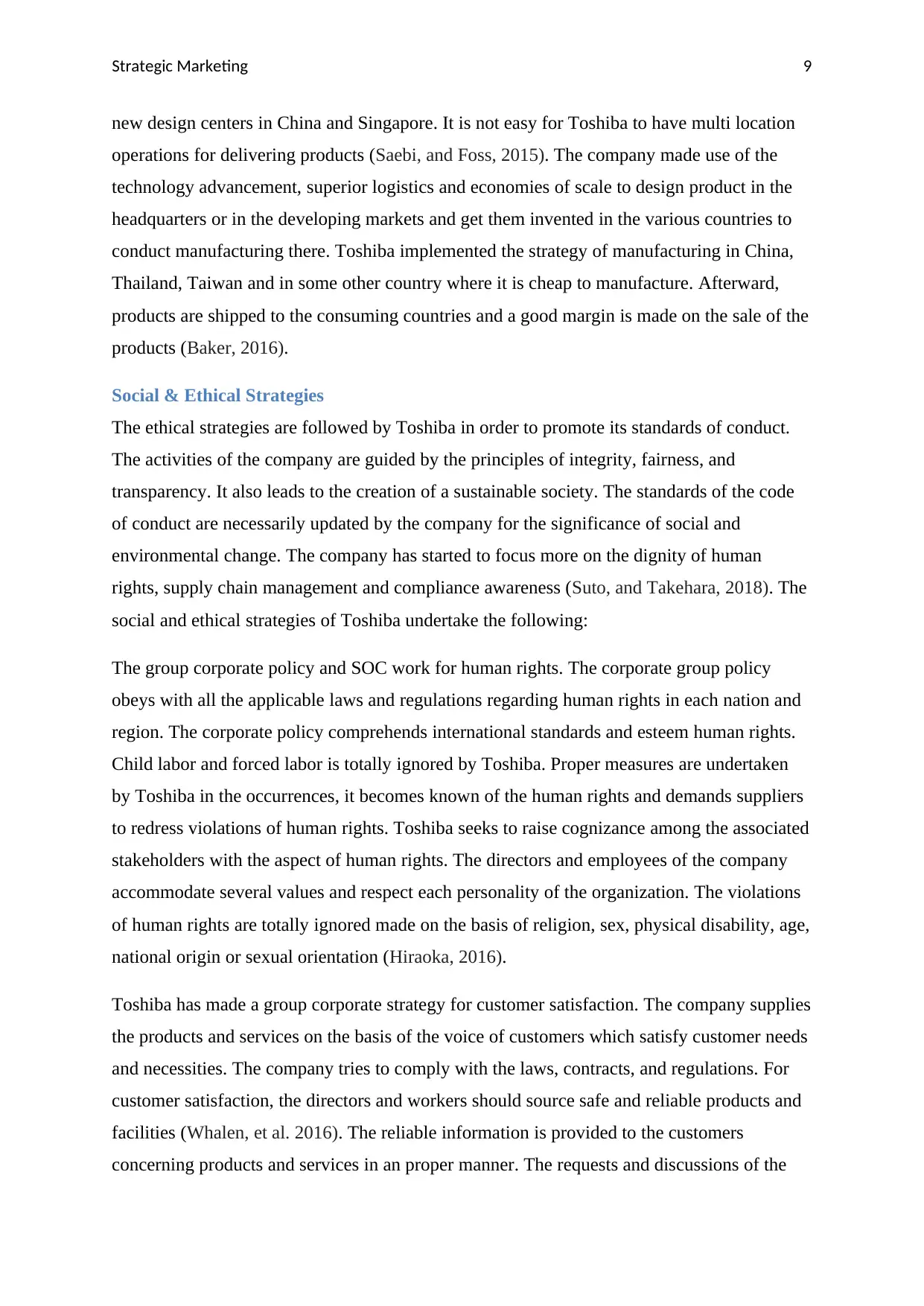
Strategic Marketing 9
new design centers in China and Singapore. It is not easy for Toshiba to have multi location
operations for delivering products (Saebi, and Foss, 2015). The company made use of the
technology advancement, superior logistics and economies of scale to design product in the
headquarters or in the developing markets and get them invented in the various countries to
conduct manufacturing there. Toshiba implemented the strategy of manufacturing in China,
Thailand, Taiwan and in some other country where it is cheap to manufacture. Afterward,
products are shipped to the consuming countries and a good margin is made on the sale of the
products (Baker, 2016).
Social & Ethical Strategies
The ethical strategies are followed by Toshiba in order to promote its standards of conduct.
The activities of the company are guided by the principles of integrity, fairness, and
transparency. It also leads to the creation of a sustainable society. The standards of the code
of conduct are necessarily updated by the company for the significance of social and
environmental change. The company has started to focus more on the dignity of human
rights, supply chain management and compliance awareness (Suto, and Takehara, 2018). The
social and ethical strategies of Toshiba undertake the following:
The group corporate policy and SOC work for human rights. The corporate group policy
obeys with all the applicable laws and regulations regarding human rights in each nation and
region. The corporate policy comprehends international standards and esteem human rights.
Child labor and forced labor is totally ignored by Toshiba. Proper measures are undertaken
by Toshiba in the occurrences, it becomes known of the human rights and demands suppliers
to redress violations of human rights. Toshiba seeks to raise cognizance among the associated
stakeholders with the aspect of human rights. The directors and employees of the company
accommodate several values and respect each personality of the organization. The violations
of human rights are totally ignored made on the basis of religion, sex, physical disability, age,
national origin or sexual orientation (Hiraoka, 2016).
Toshiba has made a group corporate strategy for customer satisfaction. The company supplies
the products and services on the basis of the voice of customers which satisfy customer needs
and necessities. The company tries to comply with the laws, contracts, and regulations. For
customer satisfaction, the directors and workers should source safe and reliable products and
facilities (Whalen, et al. 2016). The reliable information is provided to the customers
concerning products and services in an proper manner. The requests and discussions of the
new design centers in China and Singapore. It is not easy for Toshiba to have multi location
operations for delivering products (Saebi, and Foss, 2015). The company made use of the
technology advancement, superior logistics and economies of scale to design product in the
headquarters or in the developing markets and get them invented in the various countries to
conduct manufacturing there. Toshiba implemented the strategy of manufacturing in China,
Thailand, Taiwan and in some other country where it is cheap to manufacture. Afterward,
products are shipped to the consuming countries and a good margin is made on the sale of the
products (Baker, 2016).
Social & Ethical Strategies
The ethical strategies are followed by Toshiba in order to promote its standards of conduct.
The activities of the company are guided by the principles of integrity, fairness, and
transparency. It also leads to the creation of a sustainable society. The standards of the code
of conduct are necessarily updated by the company for the significance of social and
environmental change. The company has started to focus more on the dignity of human
rights, supply chain management and compliance awareness (Suto, and Takehara, 2018). The
social and ethical strategies of Toshiba undertake the following:
The group corporate policy and SOC work for human rights. The corporate group policy
obeys with all the applicable laws and regulations regarding human rights in each nation and
region. The corporate policy comprehends international standards and esteem human rights.
Child labor and forced labor is totally ignored by Toshiba. Proper measures are undertaken
by Toshiba in the occurrences, it becomes known of the human rights and demands suppliers
to redress violations of human rights. Toshiba seeks to raise cognizance among the associated
stakeholders with the aspect of human rights. The directors and employees of the company
accommodate several values and respect each personality of the organization. The violations
of human rights are totally ignored made on the basis of religion, sex, physical disability, age,
national origin or sexual orientation (Hiraoka, 2016).
Toshiba has made a group corporate strategy for customer satisfaction. The company supplies
the products and services on the basis of the voice of customers which satisfy customer needs
and necessities. The company tries to comply with the laws, contracts, and regulations. For
customer satisfaction, the directors and workers should source safe and reliable products and
facilities (Whalen, et al. 2016). The reliable information is provided to the customers
concerning products and services in an proper manner. The requests and discussions of the
Paraphrase This Document
Need a fresh take? Get an instant paraphrase of this document with our AI Paraphraser
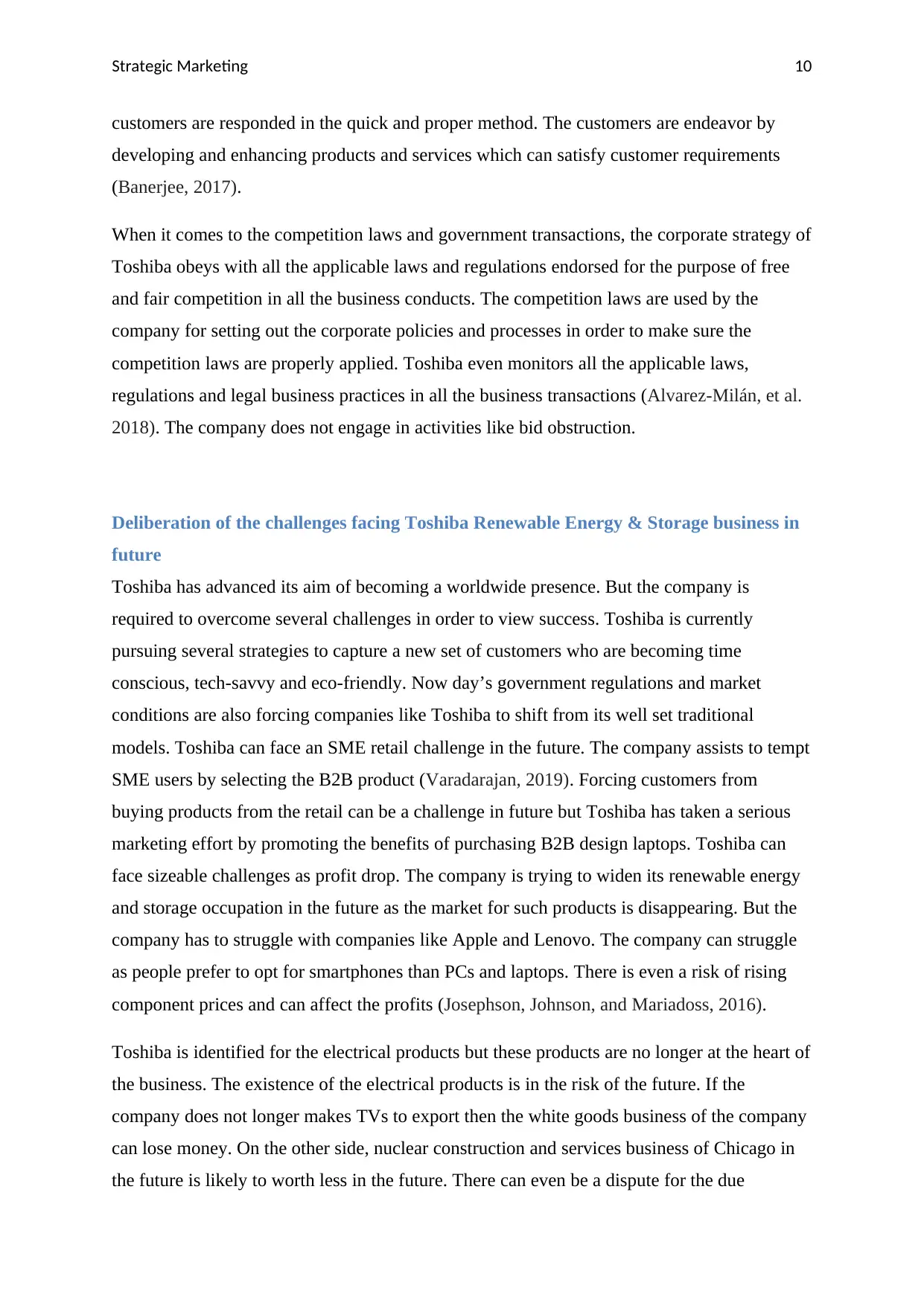
Strategic Marketing 10
customers are responded in the quick and proper method. The customers are endeavor by
developing and enhancing products and services which can satisfy customer requirements
(Banerjee, 2017).
When it comes to the competition laws and government transactions, the corporate strategy of
Toshiba obeys with all the applicable laws and regulations endorsed for the purpose of free
and fair competition in all the business conducts. The competition laws are used by the
company for setting out the corporate policies and processes in order to make sure the
competition laws are properly applied. Toshiba even monitors all the applicable laws,
regulations and legal business practices in all the business transactions (Alvarez-Milán, et al.
2018). The company does not engage in activities like bid obstruction.
Deliberation of the challenges facing Toshiba Renewable Energy & Storage business in
future
Toshiba has advanced its aim of becoming a worldwide presence. But the company is
required to overcome several challenges in order to view success. Toshiba is currently
pursuing several strategies to capture a new set of customers who are becoming time
conscious, tech-savvy and eco-friendly. Now day’s government regulations and market
conditions are also forcing companies like Toshiba to shift from its well set traditional
models. Toshiba can face an SME retail challenge in the future. The company assists to tempt
SME users by selecting the B2B product (Varadarajan, 2019). Forcing customers from
buying products from the retail can be a challenge in future but Toshiba has taken a serious
marketing effort by promoting the benefits of purchasing B2B design laptops. Toshiba can
face sizeable challenges as profit drop. The company is trying to widen its renewable energy
and storage occupation in the future as the market for such products is disappearing. But the
company has to struggle with companies like Apple and Lenovo. The company can struggle
as people prefer to opt for smartphones than PCs and laptops. There is even a risk of rising
component prices and can affect the profits (Josephson, Johnson, and Mariadoss, 2016).
Toshiba is identified for the electrical products but these products are no longer at the heart of
the business. The existence of the electrical products is in the risk of the future. If the
company does not longer makes TVs to export then the white goods business of the company
can lose money. On the other side, nuclear construction and services business of Chicago in
the future is likely to worth less in the future. There can even be a dispute for the due
customers are responded in the quick and proper method. The customers are endeavor by
developing and enhancing products and services which can satisfy customer requirements
(Banerjee, 2017).
When it comes to the competition laws and government transactions, the corporate strategy of
Toshiba obeys with all the applicable laws and regulations endorsed for the purpose of free
and fair competition in all the business conducts. The competition laws are used by the
company for setting out the corporate policies and processes in order to make sure the
competition laws are properly applied. Toshiba even monitors all the applicable laws,
regulations and legal business practices in all the business transactions (Alvarez-Milán, et al.
2018). The company does not engage in activities like bid obstruction.
Deliberation of the challenges facing Toshiba Renewable Energy & Storage business in
future
Toshiba has advanced its aim of becoming a worldwide presence. But the company is
required to overcome several challenges in order to view success. Toshiba is currently
pursuing several strategies to capture a new set of customers who are becoming time
conscious, tech-savvy and eco-friendly. Now day’s government regulations and market
conditions are also forcing companies like Toshiba to shift from its well set traditional
models. Toshiba can face an SME retail challenge in the future. The company assists to tempt
SME users by selecting the B2B product (Varadarajan, 2019). Forcing customers from
buying products from the retail can be a challenge in future but Toshiba has taken a serious
marketing effort by promoting the benefits of purchasing B2B design laptops. Toshiba can
face sizeable challenges as profit drop. The company is trying to widen its renewable energy
and storage occupation in the future as the market for such products is disappearing. But the
company has to struggle with companies like Apple and Lenovo. The company can struggle
as people prefer to opt for smartphones than PCs and laptops. There is even a risk of rising
component prices and can affect the profits (Josephson, Johnson, and Mariadoss, 2016).
Toshiba is identified for the electrical products but these products are no longer at the heart of
the business. The existence of the electrical products is in the risk of the future. If the
company does not longer makes TVs to export then the white goods business of the company
can lose money. On the other side, nuclear construction and services business of Chicago in
the future is likely to worth less in the future. There can even be a dispute for the due
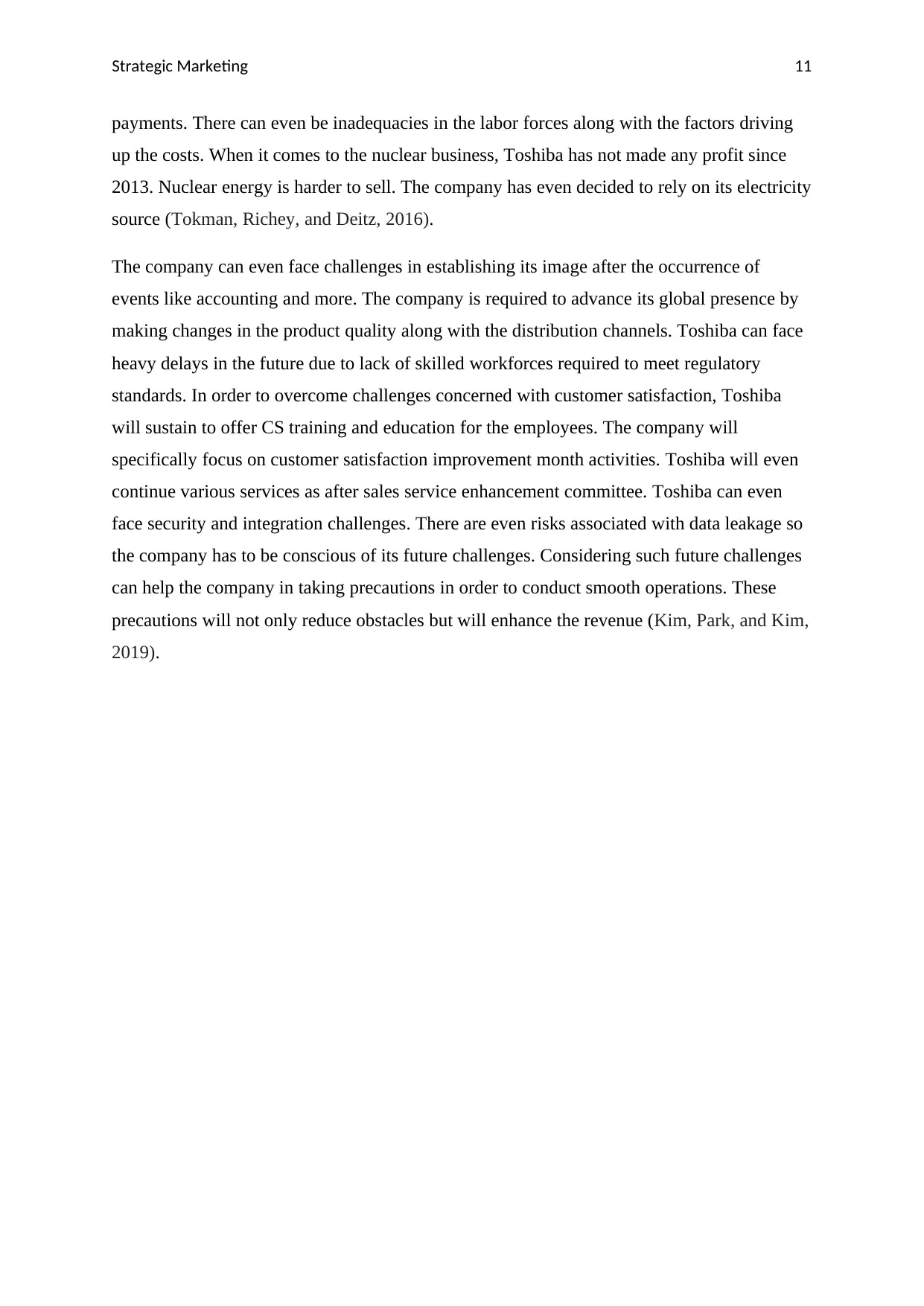
Strategic Marketing 11
payments. There can even be inadequacies in the labor forces along with the factors driving
up the costs. When it comes to the nuclear business, Toshiba has not made any profit since
2013. Nuclear energy is harder to sell. The company has even decided to rely on its electricity
source (Tokman, Richey, and Deitz, 2016).
The company can even face challenges in establishing its image after the occurrence of
events like accounting and more. The company is required to advance its global presence by
making changes in the product quality along with the distribution channels. Toshiba can face
heavy delays in the future due to lack of skilled workforces required to meet regulatory
standards. In order to overcome challenges concerned with customer satisfaction, Toshiba
will sustain to offer CS training and education for the employees. The company will
specifically focus on customer satisfaction improvement month activities. Toshiba will even
continue various services as after sales service enhancement committee. Toshiba can even
face security and integration challenges. There are even risks associated with data leakage so
the company has to be conscious of its future challenges. Considering such future challenges
can help the company in taking precautions in order to conduct smooth operations. These
precautions will not only reduce obstacles but will enhance the revenue (Kim, Park, and Kim,
2019).
payments. There can even be inadequacies in the labor forces along with the factors driving
up the costs. When it comes to the nuclear business, Toshiba has not made any profit since
2013. Nuclear energy is harder to sell. The company has even decided to rely on its electricity
source (Tokman, Richey, and Deitz, 2016).
The company can even face challenges in establishing its image after the occurrence of
events like accounting and more. The company is required to advance its global presence by
making changes in the product quality along with the distribution channels. Toshiba can face
heavy delays in the future due to lack of skilled workforces required to meet regulatory
standards. In order to overcome challenges concerned with customer satisfaction, Toshiba
will sustain to offer CS training and education for the employees. The company will
specifically focus on customer satisfaction improvement month activities. Toshiba will even
continue various services as after sales service enhancement committee. Toshiba can even
face security and integration challenges. There are even risks associated with data leakage so
the company has to be conscious of its future challenges. Considering such future challenges
can help the company in taking precautions in order to conduct smooth operations. These
precautions will not only reduce obstacles but will enhance the revenue (Kim, Park, and Kim,
2019).
⊘ This is a preview!⊘
Do you want full access?
Subscribe today to unlock all pages.

Trusted by 1+ million students worldwide
1 out of 17
Related Documents
Your All-in-One AI-Powered Toolkit for Academic Success.
+13062052269
info@desklib.com
Available 24*7 on WhatsApp / Email
![[object Object]](/_next/static/media/star-bottom.7253800d.svg)
Unlock your academic potential
Copyright © 2020–2025 A2Z Services. All Rights Reserved. Developed and managed by ZUCOL.





